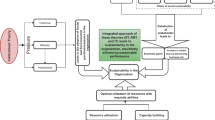Abstract
Purpose
Sustainable manufacturing is practiced globally as a comprehensive strategy for improving the sustainability performance of the manufacturing industry. While sustainability is characterized into such three dimensions as economic, environmental, and social, currently, there is no quantitative method yet to measure the so-called “sustainability” in the manufacturing industry. The objective of this research is to develop a comprehensive and effective quantitative method to measure the overall sustainability performance of manufacturing companies.
Methods
In this paper, an integrated methodology is presented for the development of composite sustainability indicators based on principal component analysis (PCA). In developing this integrated approach, both industry and academia surveys are conducted to identify what sustainability indicators are favored by the sustainable manufacturing community. A unique index is then generated to measure the overall sustainability performance of industrial practices. The methodology can be used for benchmarking the overall sustainability performance of various manufacturing companies.
Results
A case study is conducted on a total of 11 global electronic manufacturing companies. The overall sustainability performance of these companies are measured, benchmarked, and ranked. The results showed that PCA is an effective approach for constructing composite sustainability indicators across environmental, economic, and social dimensions.
Conclusions
From this research, it is found that industry and academia have different views on the sustainability measurement, evidenced by different weights put on the same indicator in industry and academia. The case study demonstrated that the methodology presented in this paper is an effective tool for comprehensive measurement of sustainability performance of manufacturing companies. Strengths and weaknesses of each company can be identified. Then, the recommended improvements can be suggested based on the study of each of the individual indicators.

Similar content being viewed by others
References
Aras G, Crowther D (2007) Sustainable corporate social responsibility and the value chain. In: Crowther D, Zain MM (eds) New perspectives on corporate social responsibility. MARA University Press, Kuala Lumpur, pp 109–128
Dahlsrud A (2008) How corporate social responsibility is defined: an analysis of 37 definitions. Corp Soc Responsib 15(1):1–13
Erhard M, Van Minnen J, Voigt T (2002) Proposed core set of climate change state and impact indicators in Europe, technical report no. XX. EEA, ETC on air and climate change, European Environment Agency, Copenhagen
Hauschild M, Dreyer LC, Joergensen A (2008) Assessing social impacts in a life cycle perspective—lessons learned. CRIP Ann-Manuf Techn 57:21–24
Hossein MH, Shinji K (2011) Dynamic sustainability assessment of countries at the macro level: a principal component analysis. Ecol Indic 11(3):811–823
Jha R, Murthy K (2003) An inverse global environmental Kuznets curve. J Comp Econ 31(2):352–368
Jollands N, Lermit J, Patterson M (2004) Aggregate eco-efficiency indices for New Zealand—a principal components analysis. J Environ Manage 73(4):293–305
Jolliffe IT (2003) Principal component analysis. Springer, New York
Krajnc D, Glavic P (2003) Indicators of sustainable production. Clean Technol Environ 5(3):279–288
Laurent A, Olsen SI, Hauschild MZ (2010) Carbon footprint as environmental performance indicator for the manufacturing industry. CRIP Ann-Manuf Techn 59:37–40
OECD (Organisation for Economic Co-operation and Development) (2002) Indicators to measure decoupling of environmental pressure from economic growth, The OECD Environment Programme. OECD, Paris
Parris TM, Kates W (2003) Characterizing and measuring sustainable development. Annu Rev Environ Resour 28:559–586
Pearson K (1901) On lines and planes of closest fit to systems of points in space. Philos Mag 2:559–572
Quarrie J (1992) The United Nations Conference on Environment and Development-Earth Summit 1992. Rio de Janeiro, Brazil
SAIC (Scientific Applications International Corporation) (2006) Life cycle assessment: principles and practice. EPA, Washington
Saltelli A (2007) Composite indicators between analysis and advocacy. Soc Indic Res 81(1):65–77
Shaw PJA (2003) Multivariate statistics for the Environmental Sciences. Hodder-Arnold, London
Soler RJ, Soler RP (2008) Assessment of aggregated indicators of sustainability using PCA: the case of apple trade in Spain. Proceedings of the 6th Int. Conf. on LCA in the Agri-Food Sector, Zurich, November 12–14, pp 133–414
Veleva V, Ellenbecker M (2001) Indicators of sustainable production: framework and methodology. J Clean Prod 9(6):519–549
Veleva V, Hart M, Greiner T, Crumbley C (2001) Indicators of sustainable production. J Clean Prod 9(5):447–452
WCED (W. C. o. E. a. D.) (1987) Our common future. Oxford University Press, Oxford
Wei J, Zhao YT, Xu HQ, Yu H (2007) A framework for selecting indicators to assess the sustainable development of the natural heritage site. J Mater Sci-Eng 4(4):321–330
Acknowledgments
The authors would like to thank the research institutions, universities, and the companies for their participation and support in our survey. The project is funded by the National Basic Research Program of China (grant no. 2011CB013406).
Author information
Authors and Affiliations
Corresponding author
Additional information
Responsible editor: Andreas Jørgensen
Rights and permissions
About this article
Cite this article
Li, T., Zhang, H., Yuan, C. et al. A PCA-based method for construction of composite sustainability indicators. Int J Life Cycle Assess 17, 593–603 (2012). https://doi.org/10.1007/s11367-012-0394-y
Received:
Accepted:
Published:
Issue Date:
DOI: https://doi.org/10.1007/s11367-012-0394-y




